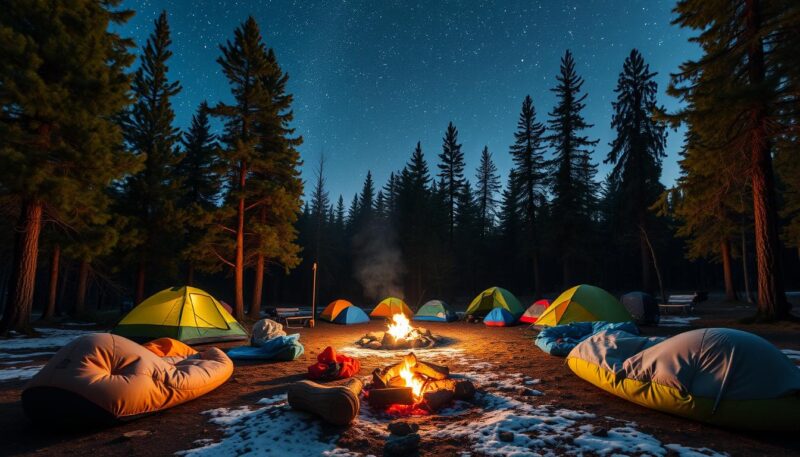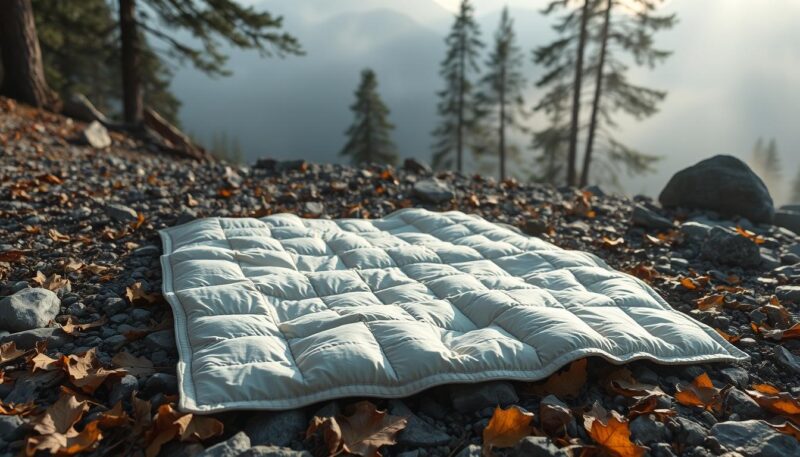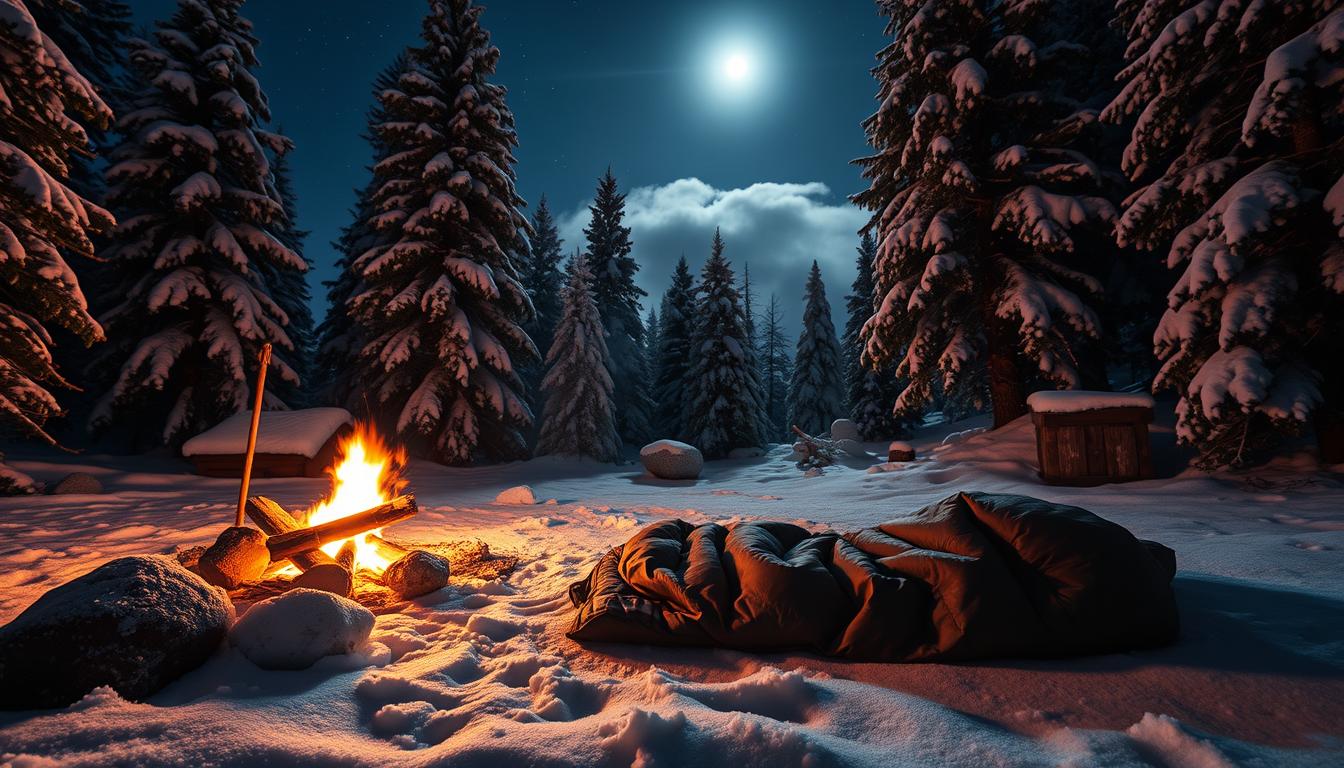When planning your next cold weather camping trip, choosing between a sleeping bag and a quilt can significantly impact your comfort and warmth. Each option has unique benefits and drawbacks, making it a highly personal decision based on your specific needs and preferences. In this comprehensive guide, we will explore the pros and cons of both sleeping bags and quilts, helping you to make an informed choice for your next adventure.
Historically, sleeping bags have been the go-to choice for cold weather camping due to their ability to encompass the entire body, trapping heat efficiently. However, modern quilts, often favored by ultra-light backpackers, offer a higher warmth-to-weight ratio and better packability despite potential drawbacks like draftiness. If you’re venturing into snowy Rocky Mountain terrain, evaluating options like the Katabatic Grenadier or the Western Mountaineering Lynx could be crucial for your survival.
Personal stories from thru-hikers and cold weather camping enthusiasts provide practical insights into the debate. For example, Mandy, known as “Veggie” on the trail, swears by the agility and compactness of her quilt paired with a Neo Air sleeping pad for sufficient warmth. The combination of a summer weight down bag with a synthetic quilt is another popular choice, enabling moisture management and versatile layering techniques.
Key Takeaways
- Sleeping bags and quilts cater to different preferences and camping conditions.
- Sleeping bags typically offer better insulation and warmth.
- Quilts often have a superior warmth-to-weight ratio and are more lightweight and packable.
- Consider the temperature range and personal comfort when choosing between a sleeping bag and quilt for cold weather adventures.
- Your choice can significantly affect your comfort and safety during camping trips in frigid conditions.
Introduction to Cold Weather Camping
For camping enthusiasts, the allure of extreme cold camping lies in its ability to transform ordinary adventures into truly unforgettable experiences. However, tackling temperatures below 10 degrees Fahrenheit requires careful preparation and the right compact gear. Winter camping presents unique challenges, from setting up a shelter to maintaining warmth, but the rewards of the crisp, serene landscapes are worth the effort.
One of the primary considerations in extreme cold camping is selecting the right sleep system, which comes down to a personal preference between sleeping bags and quilts. Each option offers distinct benefits and challenges, tailored to different needs and situations. Camping enthusiasts often debate these options, weighing factors like weight, warmth, and convenience.
It’s essential to test out your gear before embarking on a long journey. Winter camping gear needs to handle both the chilling temperatures and the rugged, unpredictable terrains. Hammock Gear 20°F Burrow Quilt, for instance, has been put to the test over 5,200 miles of backpacking trips, showcasing its durability and reliability.
In cold weather conditions, you also need to consider the ground insulation. A high R-value sleeping pad can mean the difference between a good night’s sleep and a night shivering from the cold. Moreover, evaluating the fill power of your quilt or sleeping bag – popular options like 850, 900, and 950 – can significantly impact insulation efficiency and weight.
While comparing specific gear like the REI Co-op Magma 30 Down Trail Quilt, which weighs 20.3 oz, and the REI Co-op Magma 30 Sleeping Bag, weighing 24.4 oz, it becomes evident that quilts are typically 17% lighter. This weight difference is crucial for those looking to minimize load. Quilts are generally 20 to 30% lighter than their sleeping bag counterparts, offering a tangible advantage for backpackers covering extensive trails like the Pacific Crest Trail or the Continental Divide Trail.
The selection process does not end with weight alone. Neck collars, width options, and enhanced attachment systems in modern quilts ensure greater comfort and efficiency. By choosing compact gear wisely, you ensure not just comfort but safety in harsh winter conditions.
Ultimately, the choice between a sleeping bag and a quilt for cold weather comes down to personal preference. Each has its merits, and understanding them can transform your extreme cold camping experience. The decision will significantly influence your comfort, warmth, and overall happiness on the trail.
Pros and Cons of Using Sleeping Bags
When it comes to choosing your sleep system for cold weather camping, sleeping bags for cold nights often come at the forefront of the conversation. They are favored by many due to their exceptional warmth and comfort. Here, we delve into the pros and cons focusing on these critical factors.
Warmth and Insulation
One of the biggest advantages of sleeping bags is their unparalleled ability to provide warmth. Traditional mummy sleeping bags, for instance, are designed to enclose your body completely, retaining heat and keeping cold drafts at bay. The hood can be cinched close, adding an extra layer of insulation for those cold nights. This makes them an ideal choice for ensuring maximum comfort during frigid conditions.

However, this tailored fit, while excellent for insulation, can be restrictive and may not suit all sleeping styles. In summary, sleeping bags for cold nights excel in providing consistent warmth but at the expense of flexibility in movement.
Weight and Packability
When considering the weight of your gear, sleeping bags can vary significantly. Down sleeping bags tend to be lighter, warmer, and more compressible compared to synthetic options. This makes them an excellent choice for backpackers looking to minimize pack weight without sacrificing warmth. However, they come with a higher price tag and are more challenging to clean than their synthetic counterparts.
On the other hand, synthetic sleeping bags are generally heavier and bulkier, but they are easier on the wallet and simpler to maintain. This duality means that your choice might pivot on a careful balance of weight, cost, and care requirements.
Versatility and Comfort
In terms of comfort, sleeping bags offer a dependable level of consistency, which is invaluable when facing the unpredictability of cold weather. They are straightforward to use, requiring minimal setup compared to quilts, which necessitate additional preparation steps such as attaching straps to your sleeping mat.
However, versatility is where sleeping bags can sometimes fall short. While improvements like high-fill-power down and half-length zippers aim to enhance the weight-to-warmth ratio, the structure of sleeping bags inherently limits their adaptability. This is particularly noticeable during warmer nights when a more flexible system might be preferable.
In conclusion, while sleeping bags excel in consistent warmth, ease of use, and comfort, they may lack in flexibility and packability compared to other sleep systems like quilts. Understanding these trade-offs will help you make an informed choice for your next cold weather camping adventure.
Advantages and Drawbacks of Quilts
Quilts have become increasingly popular among backpackers and outdoor enthusiasts looking for lightweight options that still offer reliable comfort and warmth. Let’s dive into the various aspects of quilts to understand their benefits and limitations.
Weight and Packability
Quilts save weight by scrapping the hood and long zippers that are commonly found on sleeping bags. This design approach can significantly reduce the overall weight, with some quilts being 20-30% lighter than traditional sleeping bags, a crucial factor for long-distance backpackers. Without the extra material and zippers, quilts are also easier to pack, making them ideal lightweight options for those who wish to minimize their load.

Temperature Regulation
One of the standout features of quilts is their superior temperature regulation. Unlike sleeping bags, which can trap heat and lead to overheating, quilts offer increased breathability. This makes them perfect for sleepers who prefer a leg out for cooling or who camp in warmer conditions. Quilts provide flexibility to adjust insulation, allowing for a cozy night’s sleep in various temperatures. Some models even come with the ability to form a closed-foot box or be tied together to create a bag-like shape for colder nights.
Setup and Ease of Use
Setting up a quilt is generally straightforward compared to a sleeping bag. Quilts can be tethered to sleeping pads to prevent drafts, enhancing their ease of use. However, they do require a bit more preparation before you crawl inside. This preparation pays off with the customization options available, such as down fill type, fabric durability, and footbox styles, that allow you to tailor the quilt to your specific needs and preferences.
These qualities make quilts an excellent choice for those seeking lightweight options and effective temperature regulation while camping. Whether you’re a seasoned hiker or a casual camper, understanding these nuances can help you make an informed choice for your next outdoor adventure.
Sleeping Bag vs Quilt: Personal Preference vs Objective Performance
The choice between a sleeping bag and a quilt often boils down to personal preference, influenced by distinct performance advantages of each option. When you’re venturing into the wilderness, it’s essential to weigh the practical considerations alongside what suits you best.
Backpacking Considerations
For many backpackers, the lightweight and versatile nature of a quilt is appealing. Quilts like the UGQ Bandit Quilt, priced at $419.95 and weighing just 22.17 oz, offer a minimalist approach to sleeping in the wild, allowing you to customize nearly every detail to meet your personal preference. With a 950 fill power and a temperature rating down to 20°F, it provides ample warmth without the bulk of a traditional sleeping bag.
Camping in Extreme Conditions
When it comes to camping in extreme conditions, the full enclosure of a sleeping bag with features like a cinching hood offers an unparalleled level of warmth. The UGQ Bandit Quilt, while versatile, may not always match the performance of a fully enclosed sleeping bag in subzero temperatures. Hiking and camping experts like Tom from Nunatak suggest that adding layers or choosing a bag with more fill can significantly increase warmth.
Layering and Sleep Systems
Layering sleep systems can offer a flexible approach to adapting between different weather conditions. For instance, using a synthetic quilt over a down sleeping bag can help manage perspiration while providing modularity in insulation. However, this method can increase complexity and overall weight. Sleep systems that incorporate quilts, like the UGQ Bandit Quilt with its customizable foot boxes and draft collars, provide adaptability throughout the seasons and reduce the need for multiple pieces of gear.
“With an Alpinist bag, you can jump the total loft from 2.5-3 inches to 5 inches just by adding another 4 ounces,” explains Tom from Nunatak, highlighting how versatile sleep systems can be.
| Feature | Sleeping Bag | Quilt |
|---|---|---|
| Weight | Heavier, includes additional insulation and features | Lighter, minimalist design without unnecessary bulk |
| Insulation | Evenly distributed with additional loft on top and bottom | Single-layer with maximum loft when sides are tucked |
| Warmth | Superior in extreme conditions due to full enclosure | Adequate for moderate conditions, dependent on layering |
| Customization | Limited to some brands with fixed features | Highly customizable, offering various foot boxes, pad attachments, etc. |
| Packability | Bulkier and takes more space in the backpack | Compacts easily, saving space and weight |
Key Factors to Consider When Choosing Your Sleep System
When making camping gear decisions for cold nights camping, several key factors come into play. Your sleep system’s effectiveness hinges on your unique needs and circumstances. Weight and packability rank high on the list, particularly for hikers and backpackers. Ultralight quilts have an edge here, being lighter and packing smaller than equivalent sleeping bags. This weight reduction is a primary appeal for those embarking on long hiking trips.
Warmth retention is another crucial consideration. Sleeping bags generally offer unparalleled warmth due to their fully enclosed design, preventing drafts and retaining body heat efficiently. Conversely, quilts often feature greater down fill, providing an impressive warmth-to-weight ratio while also allowing for flexibility in temperature regulation. This ability to adjust from a blanket-like setup on warmer nights to a snug, cinched configuration in colder conditions makes quilts an attractive option for many campers.
Comfort is subjective and highly personal. Sleeping bags offer a secured, cocoon-like environment that many find reassuring in cold weather. Quilts, on the other hand, provide the freedom to move and spread out, simulating the sleeping experience from home. This quality is particularly beneficial for those who dislike the restrictive mummy shape of most sleeping bags. Moreover, quilts are increasingly popular for hammock camping due to their ease of movement and the inefficacy of compressed insulation in sleeping bags.
Another point to consider in your camping gear decisions is the level of setup and ease of use. Sleeping bags are straightforward: unzip, crawl in, and zip up. Quilts require slightly more preparation, such as attaching straps to sleeping mats. However, their flexibility in terms of customization—allowing you to choose down fill power, fabric durability, and even specific dimensions—adds a level of personalization unmatched by standard sleeping bags.
| Factors | Sleeping Bags | Quilts |
|---|---|---|
| Weight and Packability | Heavier, bulkier | Lighter, compact |
| Warmth | Better warmth retention | Good warmth-to-weight ratio, better for warmer conditions |
| Comfort | Enclosed, cocoon-like | Freedom of movement |
| Setup and Ease of Use | Easy, minimal setup | Requires more preparation (straps, clips) |
| Customization | Less customizable | Highly customizable |
Ultimately, your choice between a sleeping bag and a quilt for cold nights camping boils down to personal preference and specific camping scenarios. By addressing factors such as warmth retention, weight and packability, comfort, and setup ease, you can make a well-informed decision to optimize your sleep system for your next adventure.
The Best Cold Weather Options on the Market
When faced with the challenge of cold weather camping, choosing the right sleep system can make a world of difference. To simplify your search, we’ve selected the top sleeping bag picks and top quilt picks that stand out in terms of warmth, weight, and overall performance. Additionally, budget-friendly options ensure no camper is left out in the cold due to financial constraints.
Top Sleeping Bag Picks
For those who prioritize comprehensive warmth in freezing conditions, sleeping bags are often the go-to choice.
- Katabatic Gear Grenadier: Renowned for handling extremely low temperatures, the Grenadier combines top-tier insulation with a lightweight design.
- Western Mountaineering Lynx: This model excels with its impressive temperature ratings and durable materials, ensuring warmth even in the harshest weather.
Top Quilt Picks
Quilts offer a different approach to warmth, often relying on a sleeping pad for insulation from the ground while providing excellent weight savings and freedom of movement.
- Enlightened Equipment: Known for customizable options, these quilts allow you to choose the warmth level, fill material, and weight, catering to a variety of camping scenarios.
- Cumulus Quilts: These quilts offer a balance of performance and packability, making them ideal for backpackers who need lightweight gear.
Budget-Friendly Options
Your budget should never limit your ability to enjoy cold weather camping. Fortunately, there are several budget-friendly options that still provide excellent warmth and comfort.
- Versatile Layering Systems: Opt for a layering approach with an overquilt to enhance insulation without breaking the bank.
- Rumpl Original Puffy Blanket: This versatile choice can serve as a comfortable layer during warmer seasons or as supplemental insulation during car camping trips.
| Feature | Top Sleeping Bag Picks | Top Quilt Picks | Budget-Friendly Options |
|---|---|---|---|
| Brands | Katabatic Gear, Western Mountaineering | Enlightened Equipment, Cumulus | Various Layering Systems, Rumpl |
| Weight | Moderate | Light | Light to Moderate |
| Temperature Rating | Low to Very Low | Varies | Varies |
| Cost | Premium | Premium | Economical |
Whether you’re considering the top sleeping bag picks, exploring the top quilt picks, or seeking budget-friendly options, always remember to match your choice to your specific camping needs. Proper gear can transform your cold weather camping experience, ensuring you stay warm and comfortable no matter the temperature.
Conclusion
When it comes to winter camping gear, the debate between sleeping bags and quilts is richly informed by personal preference and the practical performance of each option. Sleeping bags offer comprehensive warmth through a fully enclosed design that minimizes air exchange and eliminates cold spots. Their temperature ratings guide campers on comfort levels, ensuring you can make well-informed camping decisions even in the chilliest conditions. In contrast, quilts, relying on your sleeping pad for ground insulation, shine in their lightweight, compressible nature, a feature ultralight backpackers greatly appreciate.
Understanding the nuances—such as the freedom of movement and ventilation provided by quilts versus the snug, all-encompassing warmth of sleeping bags—can direct you towards the best choice for your outdoor adventures. For some, the adaptability of quilts, which allows easy customization for different warmth levels and the integration with sleeping pads, stands out. For others, the reliable warmth and element protection offered by sleeping bags, especially in cold weather and alpine conditions, are indispensable. Your sleep comfort, defined by whether you prefer the roomy rectangular sleeping bags or the free-range movement offered by quilts, plays a critical role in this decision-making process.
Ultimately, making informed camping decisions relies on balancing these factors to match your camping style, whether it’s ultralight backpacking or enduring the biting cold of winter nights. With the knowledge shared by experienced outdoors people and a clear understanding of the strengths and limitations of both sleeping bags and quilts, you can enhance your comfort and enjoyment of the great outdoors. Prioritizing personal comfort, warmth, and practicality ensures every camping experience is both safe and pleasurable.
FAQ
What are the main advantages of using a sleeping bag for cold weather camping?
Sleeping bags offer excellent warmth and insulation due to their ability to enclose the body, keeping warm air in and cold drafts out. Their tailored fit and the inclusion of a hood that can be cinched close make them ideal for extreme cold conditions, especially when temperatures drop below 20°F. Brands like Katabatic Gear’s Grenadier and Western Mountaineering’s Lynx are examples of top choices for such temperatures.
How do quilts compare to sleeping bags in terms of weight and packability?
Quilts are particularly valued in the ultralight backpacking community due to their significant weight savings, being 20-30% lighter than sleeping bags. This weight reduction is achieved through less material and the absence of zippers, making quilts highly packable and ideal for long-distance backpackers who prioritize lightweight gear.
What considerations should be made for temperature regulation when using a quilt?
Quilts offer increased breathability and adaptability, making them suitable for sleepers who prefer to regulate their temperature by sticking a leg out or who frequently camp in warmer conditions. However, in colder weather, it’s essential to correctly tether your quilt to your sleeping pad to prevent drafts and maintain warmth.
How do sleeping bags and quilts compare in terms of versatility and comfort?
Traditionally, sleeping bags are less versatile due to their enclosed structure, which might restrict movement for some sleepers. Quilts, on the other hand, offer flexibility as they can be structured with a closed-foot box or tied together to form a bag-like shape. This makes quilts a versatile option across different conditions, providing a balance of comfort and functionality.
What are the key backpacking considerations when choosing between a sleeping bag and a quilt?
For backpackers, the primary considerations include weight, packability, and ease of use. Quilts typically hold an advantage in these areas due to their lightweight design and compact nature. However, the potential for drafts with quilts and their suitability in very cold temperatures need to be weighed carefully against the secure warmth provided by sleeping bags.
Can layering systems be effective for cold weather camping?
Yes, layering systems can effectively enhance warmth and versatility. For example, campers often layer a down sleeping bag with a synthetic quilt to manage moisture from perspiration and add extra insulation. This approach provides a modular sleep system that can be adjusted based on varying temperature conditions and helps spread the warmth across different layers.
What are the top quilt brands for cold weather camping?
Enlightened Equipment and Cumulus are popular brands for customizable quilts, offering a variety of warmth levels and fill materials. These brands are known for their high-quality down and shell options, enabling campers to select quilts that precisely match their cold weather needs.
What budget-friendly options are available for cold weather camping?
For those on a budget, versatile layering systems and affordable gear like the Rumpl Original Puffy Blanket can provide cost-effective solutions. These options offer flexibility and an added layer of warmth when used in conjunction with other sleep gear, making them practical for both car camping and backpacking.
Source Links
- https://www.switchbacktravel.com/info/sleeping-bags-vs-quilts
- https://backpackinglight.com/forums/topic/cold-weather-bag-quilt-vs-sleeping-bag/
- https://www.ukclimbing.com/forums/gear/quilts_vs_sleeping_bags-769650
- https://www.erinexploring.com/blog/ultimate-backpacking-quilt-guide
- https://www.thehikinglife.com/2017/11/why-choose-a-quilt-over-a-sleeping-bag/
- https://ultralighthiker.com.au/blogs/all/a-quilt-or-sleeping-bag-what-is-right-for-you?srsltid=AfmBOoqDy6r8UhdKW-An5jvaRPa2faM5lij35uOqoKq7Pwh-vJUb8crQ
- https://coolofthewild.com/sleeping-bags-vs-quilts/
- https://ultralighthiker.com.au/blogs/all/a-quilt-or-sleeping-bag-what-is-right-for-you?srsltid=AfmBOoqSllicC8Iz6rH0vkO7ujrJZA1GamugsmHj-4qxfllKRdeBUNNE
- https://backpackinglight.com/forums/topic/14679/
- https://thetrek.co/ugq-bandit-backpacking-quilt-review/
- https://backpackinglight.com/forums/topic/11349/
- https://altongoods.com/blogs/journal/sleeping-bag-vs-quilt-which-is-best?srsltid=AfmBOopKg48bgS-Ewm5u2dpuaDbNEMDQGav6InOgOULKbSrGZdfi31Dh
- https://ultralighthiker.com.au/blogs/all/a-quilt-or-sleeping-bag-what-is-right-for-you?srsltid=AfmBOooxbhP38kweJM1D3nRV4mhLqa2BAgU7kFKHwQjwjPhdIMaP9kag
- https://backpackinglight.com/forums/topic/61048/
- https://puffy.com/blogs/best-sleep/quilt-vs-sleeping-bag?srsltid=AfmBOooZMvvJH0xtKBBxg1QloebLSteYBOiGRaDtGgCYetArU1ltvmaS
- https://argalioutdoors.com/advice/backcountry-hunting-sleeping-bags-or-quilts?srsltid=AfmBOopl8c-MShsshR0EGTOes212upLNAes_OoA0AA5vwe8OXIeD8tYq
- https://www.garagegrowngear.com/blogs/trends-top-10/quilts-vs-sleeping-bags?srsltid=AfmBOoqeWaWpGrC0zPXtSsiGPVAWzPNq3Ekht9K0qzqdXQdU07jilree
- https://puffy.com/blogs/best-sleep/quilt-vs-sleeping-bag?srsltid=AfmBOookTynGtPEc9DtjofR1olwj1tp386tBavvg5ESJeQVajzNXlPEr
- https://byland.co/blog/sleeping-bags-vs-sleeping-quilts

